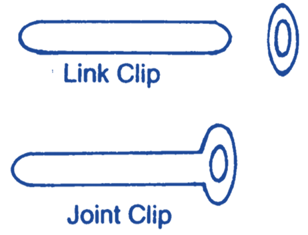In this system teak wood batten of different sizes are used. The battens are available in different sizes according to the width and breadth. The width are 13, 19, 25, 31, 38, 44, 50, 63, 69 and 75 mm, the breadth 13 mm and 19 mm. The wiring is also of two types:
- CTS or TRS batten wiring.
- Lead alloy sheathed batten wiring or lead covered cable wiring.
CTS or TRS batten wiring
In this system CTS or TRS wires are used. The wires may be single core or twin cores. In most of the cases single core cable is used. The wires are fixed on the wooden batten with the help of teak wood batten by means of clips. The clips are also of two types the link clips and joint clips as shown in Fig. 1. These clips are made of iron or lead or sometimes fibre. These are available length-wise 16 mm, 25 mm, 30 mm, 40 mm, 50 mm, 80 mm etc.

Fig. 1: Batten Wiring
Advantages of Batten Wiring
- Semi-skilled worker can do it, so the labour cost is less.
- It is less costly than casing and capping.
- It has good appearance.
- It has long life.
- The CTS. wire is not so effected by the moisture, therefore, this wiring can be done in damp places also.
- If round cleats are used and batten is painted and varnished then the wiring is free from moisture vermins etc.
- If single core wire is used then the extension is very easy, fault location is very easy and removal Of the wiring is also easy.
Disadvantages of Batten Wiring
- There is no safety from fire and shock.
- It cannot be done in the places where it is exposed to sun and rains.
General rules for wiring
- In damp places round porcelain cleats must be used and the batten be painted and varnished.
- In damp places the metallic batten holders and other metallic accessories be earthed.
- There should not be any tension on the wires.
- The joints should be in joint cutouts.
- The maximum distance between two round cleats in no case be more than 75 cm and the safe distance is 30 cm.
- All the plugs and metallic installations should be earthed.
- When the wires of opposite polarity are crossing the bridges should be used.
- If the wiring is to cross a wall or ceiling the conduit pipe should be used.
- While fixing the clips on the batten, it should be kept in mind that the horizontal distance between the clips should not be more than 12 cm and the vertical distance 18 cm.
Uses: It is a general purpose domestic wiring and generally used in house wiring.